BUILDING, RACING & BREAKING THE 2021 KAWASAKI KX450X AT LAKE HAVASU
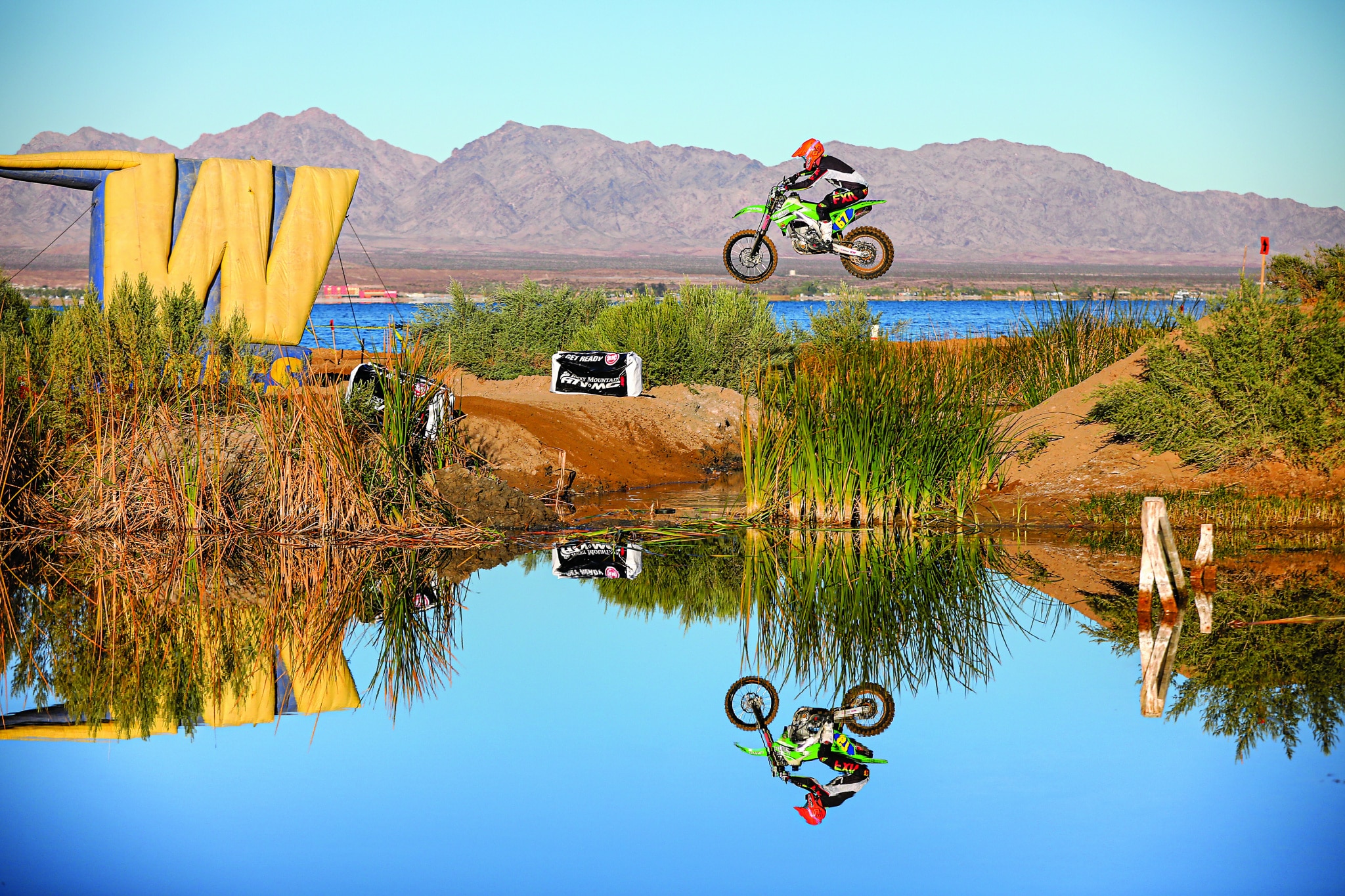
BY JOSH MOSIMAN
The idea to line up for the Lake Havasu WORCS race didn’t come to me on a whim. I’ve raced it twice before and was looking for an opportunity to do it again. Out of all the Grand Prix off-road races on the West Coast, Lake Havasu has the roughest track and the most unique location. Plus, there aren’t any technical trails or rocks there; it’s basically just a long and sandy motocross track with portions of it directly on the beach. It’s really cool. When I first heard that Kawasaki was introducing the new KX450X cross-country model for 2021, I threw my hand up quickly, asking to take it racing. I already had the event and date planned out.
BEFORE LINING UP, I HAD A FEW MUST-DO UPGRADES ON MY LIST. MY BOSS DARYL ECKLUND WANTED ME TO RACE THE BIKE STOCK, BUT EVENTUALLY I CONVINCED HIM TO LET ME UPGRADE A FEW ITEMS.
Out of all the 2020 450s, I spent the most time riding MXA’s 2020 Kawasaki KX450. I even used it to build my first official project bike for the magazine. I appreciate the nimble handling and snappy throttle characteristics of the green machine. The 2021 model year marked Kawasaki’s resurgence back into the off-road scene, and I was excited to build the KX450X into a cross-country race bike to see how it would perform in Lake Havasu against a stacked field of 450 Pro riders.
The cross-country KX450X isn’t all that different from the KX450 motocross version. Here’s the cut-to-the-bone list of off-road-specific components that Kawasaki changed on the KX450X: (1) 18-inch rear wheel. (2) Softer suspension settings. (3) 240mm rear brake rotor instead of 250mm. (4) Front brake pads. (5) 51-tooth rear sprocket instead of 50. (6) Dunlop AT-81 tires. (7) Engine protectors and rear brake rotor guard. (8) Kickstand. (9) The retail price was $9599, an extra $200 over the motocross version.
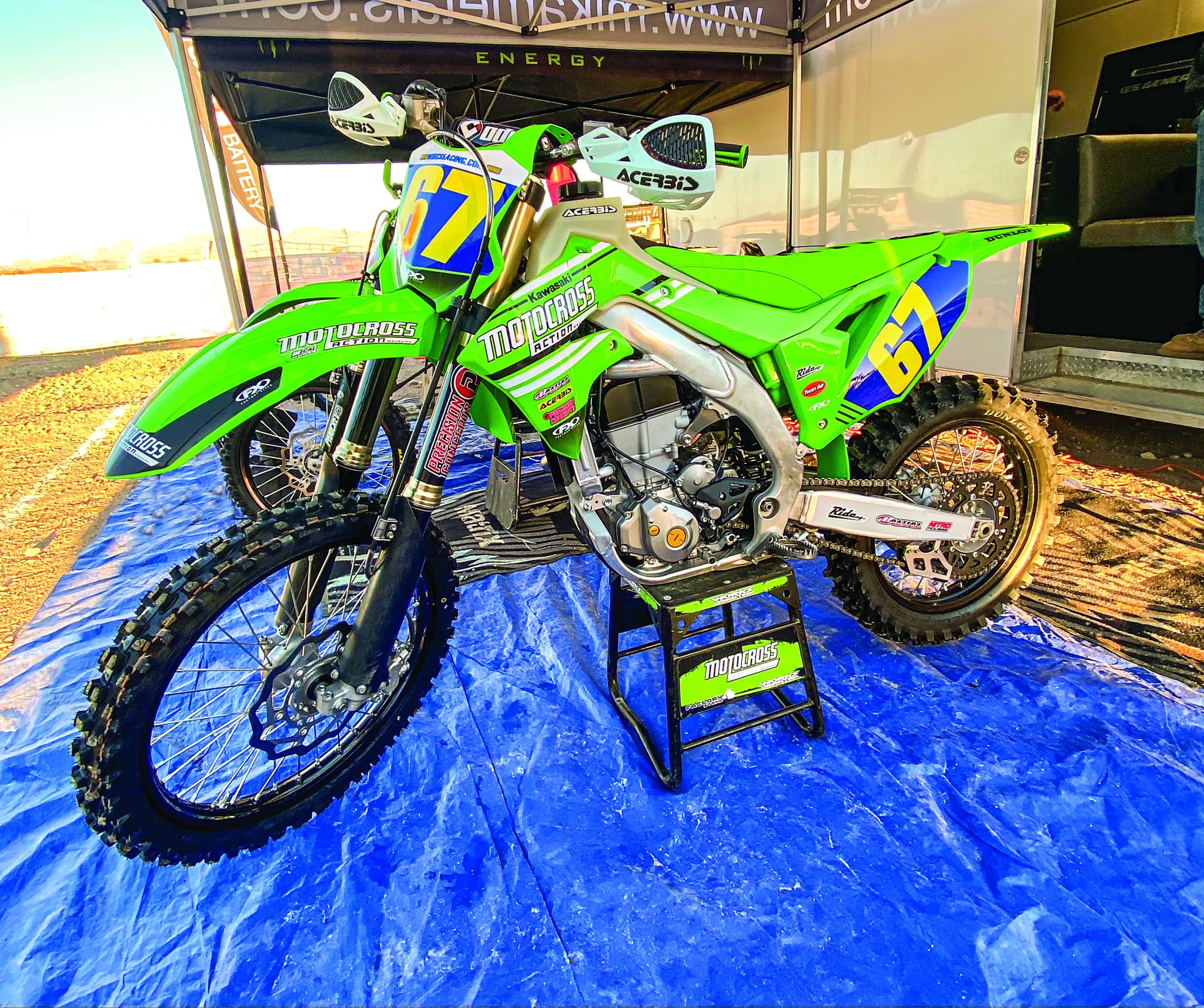
My boss Daryl Ecklund wanted me to race the bike stock, but eventually I convinced him to let me upgrade a few items. For any real off-road racing (or even riding), the KX450X needs an oversized tank. If I were a Novice-level rider, the suspension settings and standard fuel tank would most likely do the trick, but for the Pro class, I needed an oversized tank and stiffer suspension for the big sand whoops that Lake Havasu is known for. Daryl knew all about the soft suspension and small tank and how rough it would be at the race from his own prior experience in Havasu. He thought it would be funny to make me suffer, and I would have said the same thing if the roles were reversed.
ALTHOUGH THE KAWASAKI KX450 SITS VERY LOW ON THE HORSEPOWER TOTEM POLE, THE THROTTLE IS RESPONSIVE AND IT RUNS SMOOTH THROUGHOUT THE POWERBAND.
Compared to the motocross version, fork spring rates on the KX450X model dropped down from a 50 N/mm to a 48 N/mm, and the shock dropped down from a 54 N/mm spring to a 52 N/mm. Plus, the shim stacks inside of the Showa forks and shock were softened up to let the suspension compress easier, requiring less force. The softer settings are great on the trail, but they give up performance when hitting jumps, sand whoops and big braking bumps at speed. Although the Lake Havasu course doesn’t have many big jumps, it’s covered in massive sand whoops that put man and machine to the test.
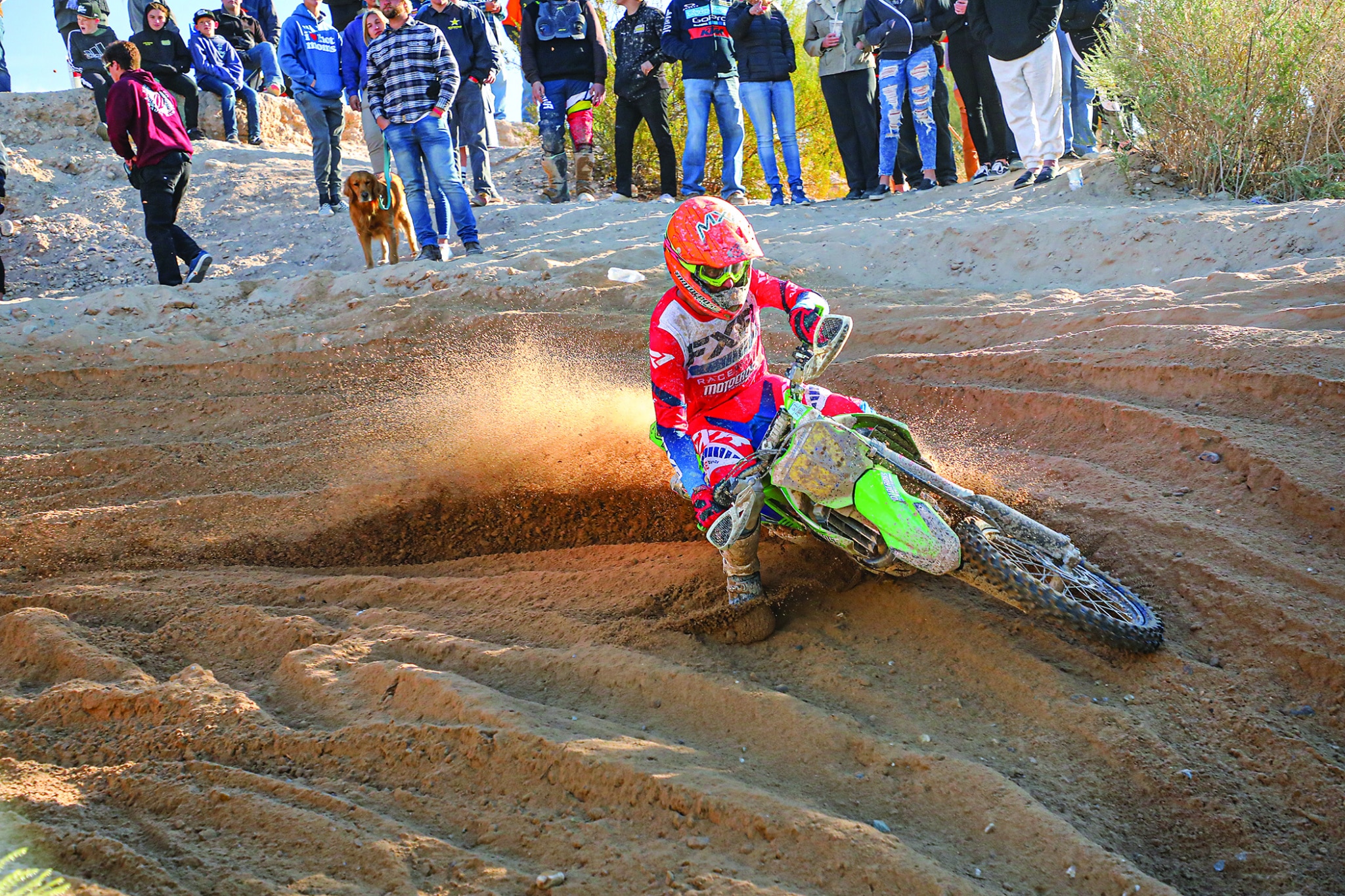
I’ve heard nothing but rave reviews regarding the Precision Concepts suspension settings for the KX450, and it makes a lot of sense if you think about it. Bob Bell, owner of the Precision Concepts shop, has been doing suspension for years. His son, Robby Bell, is a highly respected name in West Coast off-road racing, with three WORCS Championships to his credit. Precision Concepts is the factory Kawasaki team for West Coast off-road racing, and they’ve been racing the Grand Prix-style tracks for years. Before setting up my suspension, Robby Bell made sure I ordered a Ride Engineering linkage, stating that it is a crucial part of their setup. The Ride Engineering link flattens out the rear end by lowering it 8mm. It adjusts the ramping curve of the shock to their liking. They also had me drop the forks in the clamps so that they were flush to continue with the theme of shifting the weight off the front end. They gave me the exact same setting as what their team captain Zach Bell (not related) uses on his KX450; my clickers were just slightly softer. Robby described their KX450 suspension as “a motocross-style setting with more comfort.”
RACING IS FUN, BUT IT’S ALWAYS MORE FUN WHEN YOU’RE WITH YOUR BUDDIES. MXA ENDURANCE TEST RIDER JOSH FOUT IS A CRUCIAL PART OF THE WRECKING CREW.
With WORCS Pro races being two-hours long, you need a big tank. Most serious Pro off-road racers use oversized quick-fill IMS tanks, but the quick-fill cap isn’t cheap, and I wasn’t interested in spending the extra money since this was my only off-road race scheduled for the KX450X. Plus, I would need to borrow (or buy) a quick-fill can with it. So, I went with the next best option. Acerbis has a 2.7-gallon oversized tank that fits cleanly on the KX450X, and I used a dump-style cap on my regular fuel can. Additionally, I never line up for an off-road race with tubes in my tires. I always switch them out for the NitroMousse system instead. With rocks embedded into the ground on the “motocross section” of the Lake Havasu course, my tires would have been flat in a lap with standard tubes. NitroMousse took the worry away. Next on my list of must-dos for the KX450X were handguards. I put on Acerbis guards to protect my hands from rocky roost and bushes I’d brush up against. I should have ordered a skid plate from Acerbis at the same time, but I figured the extra protection on the “X” model would be good enough—I was wrong. I also replaced the Dunlop AT-81 tires with a Dunlop MX33 front and MX12 rear. If I were trail riding and wanted better durability, I’d stick with the AT-81 pattern that comes stock, but since I was racing, I wanted the best traction possible. The MX33 front was a no-brainer, but I contemplated running the MX12 sand/mud scoop tire in the rear for a few weeks. My last time racing in Lake Havasu was over a year earlier, and although there’s more sand than hard soil, I was skeptical about whether the time I made up in the deep sand would be comparable to the time I might lose on the hard-pack sections. With nothing but pride on the line, I decided the MX12’s reward was worth the risk.

I enjoy riding 450s, but I hate it when they’re too fast. The KX450 engine allows me to ride hard with fewer mistakes and less fatigue. Plus, the race in Lake Havasu has mostly switchback corners, and the straights aren’t super long. With that, I didn’t need to go all out with horsepower on my build. I swapped out the ultra-long and ugly stock muffler for a full Pro Circuit T-6 stainless system. This woke the engine up by giving it more power, made the bike look racier and added some durability. How so? Well, the Pro Circuit muffler mount uses the same style rubber fitting as the stock KX450 muffler, while some other aftermarket brands use solid mounts that need to be reinforced with brackets or they’ll cause the subframe to crack. Since I was racing at one of the toughest Grand Prix courses on the West Coast, I figured the Pro Circuit system, with the more reliable stock-style muffler mount, was my best choice. Next, I dropped from a 51- to a 50-tooth Supersprox rear sprocket to spread out the gear ratios, and I used a Twin Air Powerflow filter cage and air filter to let the KX450X breathe easier.
Other parts added were ODI Podium Flight handlebars with my favorite ODI Emig Pro V2 lock-on grips. I replaced the weird KX450 levers (the front brake is skinnier than the clutch lever) with ARC Levers. I used Acerbis X-Grip frame guards, Scar Racing titanium foot pegs and a Factory Effex RS1 gripper seat cover to help me hold onto the bike easier and save some energy for the long and grueling race. I removed the kickstand and added Factory Effex graphics with the blue and yellow background colors, which were required to signify I’m in the Pro class.
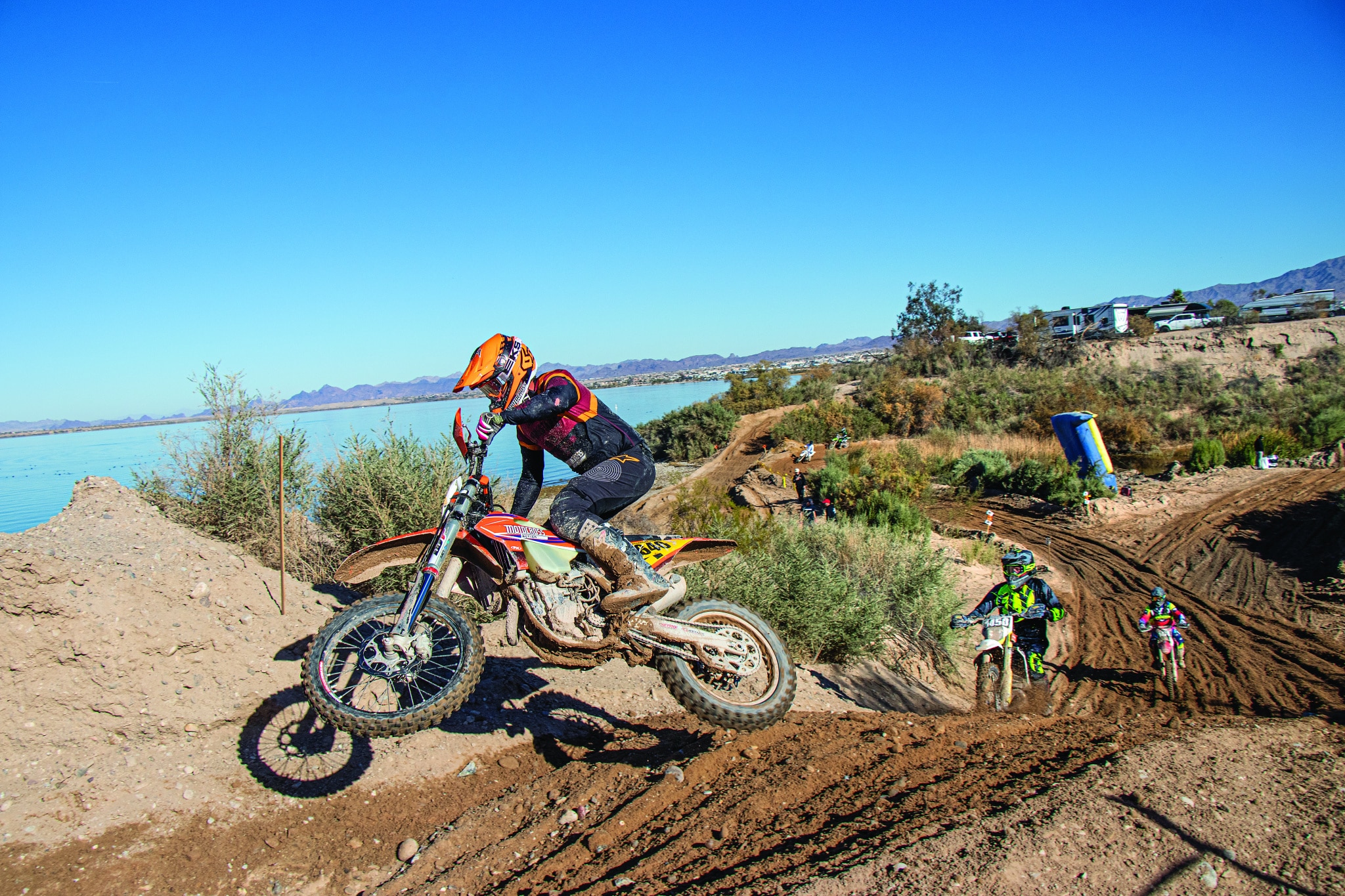
Just barely 30 years old, Josh Fout has been giving MXA feedback on motorcycles since he was a Novice. But, he’s not a Novice anymore. He’s been racing every weekend with Jody and the whole MXA crew of test riders for years, and he’s been getting faster at a rapid rate. Now he’s a fast intermediate. Josh joined me for the Havasu weekend, and he brought MXA’s 2021 KTM 450XCF for his first trip to the sandy Grand Prix track in Arizona. The 450XCF model comes stock with an oversized tank, handguards, 18-inch rear wheel, kickstand, Dunlop AT81 tires, and softer, cross-country-style suspension. The only parts we added onto the KTM for Josh were NitroMousse inserts, a Dunlop MX33 front tire and an MX12 sand tire for the rear. We also added ODI handlebars, Emig Pro V2 Lock-on grips and a Factory Effex seat cover and graphics.
THE TRACK HAD A VERY DIFFERENT LAYOUT FROM THE PREVIOUS TWO TIMES I HAD BEEN THERE, BUT I LEARNED IT QUICKLY.
My practice started off well. It was only a 30-minute practice, but with 5-minute lap times and the conditions already getting super rough, I didn’t need too much time. I was feeling comfortable, and after charging hard for a few laps I pulled into the mechanics’ area to catch my breath and check my lap times. Even though it wasn’t a timed qualifying session like WORCS used to have in 2019 when I raced there last, I still wanted to see how I was doing. I saw Robby Bell in the mechanics’ area, and luckily his mechanic Phil Valdez saw that I had oil all over my boot and left-side engine cases. A rock had hit my ignition cover, puncturing a hole in it and causing oil to spill out. I was very lucky for two reasons: (1) I pulled over before anything internal broke. (2) I was already talking with the only person at the track who could help. Thankfully, Robby offered to give me the ignition cover off his personal Precision Concepts KX450X after he was done racing it in the Vet Pro class. I was back in business.
At this point, I wished I would have ordered a full skid plate from Acerbis. The KX450X has a minimal skid plate that only offers protection between the bottom frame rails. It also has one engine guard on the right side for the water pump but nothing on the left side where my domed ignition cover was vulnerable. Thankfully, we drained the oil from the engine and it was clean. There was hardly any dirt underneath the cover, only a few small particles.

Usually, the Pro race takes off at 1 p.m. on Sunday, but the WORCS schedule was mixed up because the Lake Havasu round was the season finale, so they were holding their awards banquet after the racing was over, and the ever-present COVID-19 pandemic caused schedule changes that forced WORCS to combine the ATV and motorcycle racing into the same weekend. With that, the race duration was cut down from two hours to one and a half hours, and the race was moved to 8:30 a.m. instead of 1 p.m.
When Sunday morning came, it was cold and the sun was still rising. Josh Fout had his race on Saturday afternoon in the 30+ 450 B class, and he won it easily. While he raced, I walked the track and took photos of him. Josh’s second class of the weekend was 450 B, and it began bright and early at 7:30 a.m. on Sunday morning; however, it wasn’t “bright” at all. It was pitch black when we showed up to the track at 6:30 a.m. and the sun was barely up when his race began. With Lake Havasu, Arizona, being right on the border of the Pacific Time Zone but still being one hour ahead in Mountain Time, the sun was slow to rise. I helped Josh on the starting line, but after he took off, I couldn’t hang out and watch. The riders meeting for the Pro class was at 7:45 a.m., and our race was set to start at 8:30 a.m. I had high expectations for Josh to win again, even though I knew the 450 B class would be tougher than the Vet competition. Unfortunately, he went down a few times, but he still crossed the line in fourth with a smile on his face.

The Pro class had some heavy hitters in it. When the time came for my race, my heart was pumping. The 15 Pro riders in the premier class started on the front row with the Pro 2 and Pro 2 Lites classes starting behind us. My start was lackluster, and I tried my best to maintain my composure and not wear myself out by trying too hard early in the race. The Lake Havasu track offers no room to rest. You are constantly pounding big sand whoops, and if you let your guard down for an instant, you will crash. I did have one advantage over the riders in front of me, though. When I looked down the starting line before our race, I noticed that Taylor Robert and I were the only riders with lowered visors. It didn’t help with style points, but as I mentioned, the sun was still rising, and it was blinding us every time we raced towards the east.
I was comfortable keeping pace with Ryan Surratt in the early laps, and we both caught up to the ninth-place rider. Coming into a right-hander, with the sun in our eyes, I saw an opportunity and jumped on it. This particular corner was full of mud on the inside, but I splashed right through it and passed two riders at once to get into ninth. I was pretty happy with myself as I made my way forward. Surprisingly, I even passed the Italian Rockstar Husqvarna factory rider (now GasGas rider) Giacomo Redondi. Unfortunately, I wasn’t able to keep Surratt or Giacomo behind me. Ryan passed me at the halfway point of the race as I started to get fatigued, and Giacomo passed me while I was in the pit lane refueling.
My strategy was to race without a hydration pack. I had water bottles with rubber straws in the caps ready for Josh Fout to hand me as I passed through the pit area. This was something I had learned from the Pro Circuit team when we won the 24-Hours of Glen Helen just two weeks earlier. With the bottles set up correctly, I could still ride with the straw in my mouth and the bottle hanging out of the bottom of my helmet. I didn’t want to carry extra weight, but I made the wrong decision. The pit area was faster and wider than it was at Glen Helen, and it took too much time for me to get off the race line to grab the water bottles from Josh. I did end up grabbing one bottle during the race, but it wasn’t enough to keep me going. The mid-section of the race was a challenge mentally and physically. After topping off on fuel, grabbing fresh goggles and getting a second water bottle, I got a second wind and was able to push to the end and cross the line in 10th in the Pro class—13th overall after being passed by 250 riders from the lines behind me.

After an hour and a half of punishment, I was happy to see the checkered flag but also sad my weekend of racing on the beaches of Lake Havasu was over. The bike was easy to ride. The suspension was plush and comfortable. Although softer than my motocross settings, it was perfect for its intended purpose, and I never felt it bottom out in the sand whoops. Even though the motocross portion of the track had some hard-pack sections, the Dunlop MX12 sand tire held up well. The sand tire uses a harder rubber durometer rating than the softer MX33 tires, and it performed exceptionally. In the sand, I didn’t feel my rear wheel searching for traction; whenever I wanted to wheelie over a bump (which I was doing on the exit of every corner), the paddle-style tread pattern hooked up.
THE PRO CLASS AT HAVASU WAS STACKED WITH MORE HEAVY HITTERS THAN USUAL. THERE WERE EIGHT FACTORY RIDERS FROM KTM, HUSQVARNA, KAWASAKI AND HONDA TEAMS.
At some point during the race, I lost the left-side 8mm Allen bolt on the bottom arm of the subframe that connects it to the main frame. Typically, my first reaction would be embarrassment, because missing bolts are usually my fault. This time, I wasn’t flustered, though, because I knew I had tightened this bolt on Wednesday. How could I be so confident? Well, when removing the shock on the KX450, you have to remove the bottom subframe bolts, and I had just done that. While in my garage, I noticed it was already loose. So, when installing the Precision Concepts shock, I triple-checked to make sure it was nice and tight. I was thoroughly confused as to how I could have lost that same bolt during the race. Kawasaki tech specialist and Damon Bradshaw’s former Yamaha mechanic, Mike Chavez told me a smart way to prevent this from happening next time. He said that when reinstalling the shock, tighten the shock and subframe bolts lightly, then take a tie-down and pull it through the rear wheel and over the subframe and rear fender. Tighten the strap to take up the slack, and then tighten down the shock and subframe bolts. The manual calls for torquing the shock bolts to 30 pound-feet on top and 26 pound-feet on the bottom and torquing the subframe bolt to 26 pound-feet. Next time, I’ll use some blue-grade Loc-Tite as well. In addition to the subframe coming loose, the stock plastics didn’t fare well, either. The stock fork guard on the right side was shattered, and the stock rear brake rotor guard was broken off. It wasn’t a pretty sight, but the bike made it to the finish line, and luckily my fork leg was still in good shape.
Next time I’m headed to Lake Havasu, I’ll know to order a full-coverage skid plate, as well as aftermarket fork guards and a rear brake rotor guard.

WHAT DOES IT COST PER LAP AT HAVASU?
Not including the 480-mile drive from my home in Southern California to the race in Lake Havasu, Arizona, or my hotel fees, I spent a total of $135 to be at the Lake Havasu WORCS race. Even with the reduced race time and my bike issues in practice, I completed a total of 23 laps and 131 minutes of seat time during the weekend. Adding up these numbers, my race cost me $5.82 per lap or $1.03 per minute (with an average lap time of approximately 5 minutes and 40 seconds). Keep in mind, the Pro class costs twice as much as the Amateur classes at WORCS, but the Pro race is longer and there’s an opportunity to win back your money. First place in the Pro class pays $1600 and, thankfully for me, I earned $100 for 10th place.
Josh Fout’s racing was slightly cheaper than mine. Racing in three classes, with the price of the first class being $55 and the second one $50 and the third for $25, he spent a total of $130 on entry fees and got 22 laps and 132 minutes of seat time with an average of 6-minute lap times. His cost was $0.98 cents per minute of riding and $5.90 per lap. Josh’s races were also trimmed by 10 minutes each for this round, which also affected the cost of each minute and lap of riding.
Although our commute from Southern California to Arizona upped the overall price for our weekend of racing, it was well worth it. Both Josh Fout and I had a blast testing our skills, our mental and physical toughness, and MXA’s newest cross-country test bikes in the Lake Havasu sand.
WORCS RACE PRICES:
$135 (total for me)
Race fee: $105 (Pro), $55 (Adult classes), $40 (Youth)
MX practice: $30 (half course on Friday)
Unclassified: $25 (Saturday full-course practice)
Weekend pass: $20 (Adult)
Parking: $10
TRAVELING EXPENSES: $366.46 total
Hotel: $177.46 (two nights)
Diesel: $153.60 (480 total miles)
Bike fuel: $35.40 (10-gallons)
PRICE BREAKDOWN:
$13,360.34 (total)
2021 Kawasaki KX450X: $9599
Precision Suspension: $948.94 (with springs/seals), $586.63 (without spring rate change)
Ride Engineering link: $219.95
Pro Circuit T-6 stainless exhaust system: $818.96
Acerbis 2.7-gallon oversized tank: $285.95
Acerbis MX Uniko vented handguards: $40.95
Acerbis X-grip frame protectors: $52.95
ODI Podium Flight 1-1/8-inch handlebars: $89.95
ODI Emig Pro V2 Lock-on grips: $28.95
Dunlop: $83.24 (MX12 rear), $77.49 (MX33 front)
NitroMousse: $134.95 (each)
Supersprox rear sprocket: $54.95
ARC levers: $79.99 (front brake), $79.99 (clutch)
Factory Effex custom graphics: $249.95
Factory Effex RS1 gripper seat cover: $69.95
Scar Racing titanium footpegs: $309.28





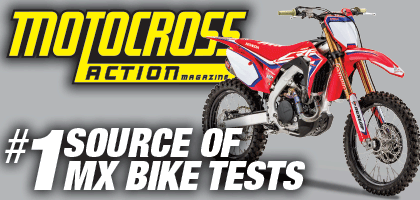


Comments are closed.